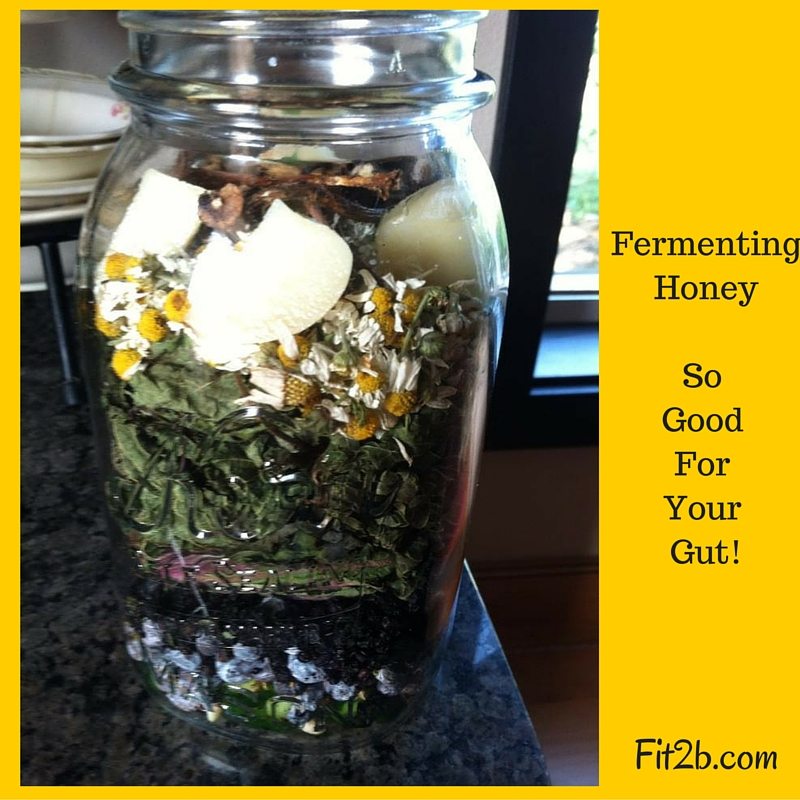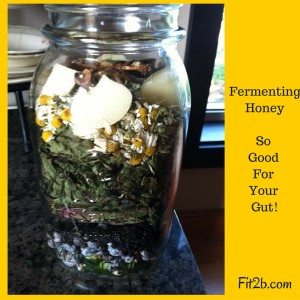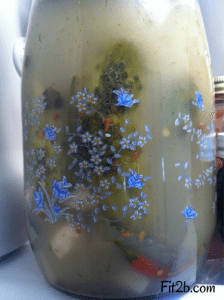Blog
Fit to Be Fermenting
“I don’t use weights. I just shake and burp daily” … Yes, this is what I caught myself saying to friends as I posted brag pics of my recent fermented adventures. My growing fascination with ferments as food started with water kefir, but I’m telling you: That stuff is a gateway drug to another lifestyle! Before I knew it, I was dabbling with sourdough starters, smuggling sweet tea into my kombucha {or “booch” as it’s nick-named} and encouraging my husband to soak his nuts.
Ahem! I’m talking about almonds and walnuts, people, Soaking your nuts overnight before eating them makes them more digestible and is a type of quick fermenting which preserves and enhances food.
Seriously now, researchers from UCLA’s Geffen School of Medicine have determined that consuming a milk fermented with probiotics changes the brain activity of women. But fermented foods aren’t just dairy-based like yogurts and cheeses. They can also be honey or bean-based. Miso, Tempeh, and Kimchi are all forms of ferments that have their own spectrum of healthy bacteria to contribute to your gut.
Here’s an awesome video that explains the human microbiome and healthy bacteria
Gut Bacteria Might Guide The Workings Of Our… by FlatBellyForeverReview03
I’ve got more nerdy articles and a couple recipes to share with you below, but what I know from experience is that fermented foods have been a huge help in getting me away from eating as much sugar! You see, when it comes to my own nutrition, what works for me is ADDING good things to my diet which end up crowding out the not-so-good things. Lately I’ve been on a fermenting kick, and sure enough: if I drink water kefir in the morning, my sugar cravings go way down!
At home, we eat really healthy 90% of the time. We have an organic garden, dry lots of fruits and veggies, raise free-range chickens for their eggs, enjoy elk meat hunted by my husband himself, and I milk a goat to get raw milk! But I praise the Lord for pre-made Costco lasagnas, and I do like my Dr. Pepper.
To perfectly candid, I don’t want to NOT WANT sugar. I like sugar. I like my coffee each morning with its 1 – just one – teaspoon of organic cane sugar. I like the occasional soda. I like the occasional bowl of cocoa pebbles.
The trouble is when “occasional” becomes “frequent,” but giving something up doesn’t necessarily solve the problem. In 2012, I gave up soda for the whole year, but the cravings didn’t go away; I just filled that craving-hole with other sugary things. Fermented foods like sauerkraut, dilly carrots, elderberry/honey/garlic syrup, water kefir, and maybe kombucha have REALLY helped reduce my sugar cravings.
But cravings aren’t mental. They don’t come from your brain. They come from your gut!
A recent study was released that proved that gut microbes manipulate behavior! Read about that on NPR here and on Forbes here. Then ponder those sugar cravings coming from the gut… ponder the notion of replacing those unhealthy yeasty bacterias over time … ponder how the messages to your brain will change. Just this past Sunday, I did the dew for the first time in months, and when I came off that high, I felt like poo for the next 5 hours. Woke up Monday with a virtual hangover. Massive sugar cravings since then. But I kept up my arsenal of fermented goodies, and today they’re gone again.
Here are some podcasts on gut health
Gut feelings: the future of psychiatry may be inside your stomach
During Pregnancy, it’s crucial for women to keep their internal bits healthy and flowing, and women who experience stress during pregnancy are likely to have babies with a poor mix of intestinal microbiota and with a higher incidence of intestinal problems and allergic reactions, yet many women worry about consuming ferments like kombucha while pregnant. They worry it’s akin to drinking wine, but two things: My OB actually prescribed I drink a glass of wine when I went past-due with my son to help me relax naturally AND I’ve had several members in our forum report that “booch” helps with morning sickness!
On another funny fermenting note: Many avid fermies recommend separating your ferments. For example, I often have sauerkraut AND a honey ferment AND water kefir AND some type of pickle all going at once. However, if I separate mine, I lose track of them. Plenty of people keep their ferments all in one cupboard with no repercussions, while others say it seems to change the flavor and cause an increase in kahm yeast. But the one time I spread my ferments out to various safe places in my home, I lost one of them completely and wandered around for an hour mumbling, “Lost my kraut. How does someone lose their kraut? Has anyone seen my kraut?”
I just spilled a whole gallon of fermented lemonade all over my kitchen counter and floor…sticky mess. While cleaning that up, my 3 year old son peed his pants. It’s been a rough 10 minutes around here. Positive – I *think* I engaged my Transverse while kneeling to clean the floor. -Julie B.
Okay, now how about some of my personal recipes?
Wait, first I need to say that I’m no expert. I’m not a foodie or fermenting philanthropist, but I’ve had some good success with countertop pickles, sauerkraut, and water kefir. I’m too good at kombucha; my home environment seems to foster epic scobies that I can’t keep up with! Then my “booch” is a little too “hooch” if you know what I mean… LOL
Beth’s Baby Dills (pictured below)
The most simple pickle recipe that works for me is making small batches of tiny baby cucumbers in a fido jar. Right now I’ve got them growing in my garden, and I try to harvest them when they’re no bigger than my thumb. I typically fill a pint-sized fido like this to within an inch from the top with pickles and water, add 1 tbs sea salt, 1-2 sprigs of dill, 3-4 halved garlic cloves, 20-30 peppercorns, and then I weigh it all down with a small vintage glass lid that fits inside so the pickles stay under the brine. I let it sit under a towel on my counter for 2-3 days, burping it 1-2 times a day by cracking it open just far enough to burp any excess gas. Tiny cukes stay crisp with no need for grape leaves. I haven’t yet perfected a recipe I like for larger pickles, but that’s okay because I love baby dills! In the jar below with pretty blue flowers, I added a couple tiny spicy peppers for some serious kick.
Note: Pickled foods aren’t the same as fermented pickles. Pickles off the shelf at your grocery have been canned, cooked, and contain additives and artificial colors like Yellow #5 … blech! The slower process of fermentation creates the good bacteria we’re after while canning kills the good along with any potential bad. I encourage you to do your own research before starting your fermentation journey.
By the way, regarding the statement in the first paragraph of this blog, of course I use weights as a fitness chick. When it comes to ferments, I find that glass weights work well for weighing down sauerkraut BUT in fido jars – which I’ve always collected for their gorgeous antique flair – I’ve had wonderful success with a daily burping and shaking… By the way, it’s best to shake AFTER you burp 😉
Pineapple Coconut Water Kefir
The hubs is on an anti-inflammatory diet, and our naturopath was delighted to hear that his wife {that’s me} was already fermenting. Now that she’s told him to try it, he’s all over me for more! His favorite drink is 2F water kefir that’s had coconut shavings and dried pineapple soaking in it.
Start by going through the 1F first ferment of grains like these in this kit which comes with fabulous instructions {it’s the same one I started with} and then add a slice of dried pineapple and a handful of dried shaved coconut to your 2F second ferment. It will get super bubbly, so watch it carefully and don’t let it go past 18-24 hours without burping it. I make all my water kefir in two plain mason canning jars with reusable plastic lids like these. Between uses, I just rinse them with water, occasionally running them through my dishwasher if they get grubby. Glass doesn’t absorb bacteria – yay!
Fermented Elderberry Honey Syrup (pictured above)
The hubs came home with a whole box of fresh elderberries last year, and I knew exactly what to do with them: Start an immediate honey ferment with a few clusters, and freeze the rest for more batches later! Concerns about raw honey aside {again, please do your own research} this recipe rocks because it kills sickness in our house so fast. Whoever gets the sniffles gets a couple spoonfuls of this each day. Plus there’s no alcohol in it like the stuff at the store!
First, find a source for local raw honey and secure at least 1 quart of it. By raw, I mean it still has bee-butts in it. Then get a large, sturdy fido jar like the one I mentioned in the pickle recipe. Sometimes you can find them at second-hand stores, but don’t use tinted ones and always check for cracks and good seals.
Layer elderberries and whatever other sick-fighting food you have on hand into the jar. Mine typically gets mostly elderberries, then quartered garlic cloves, jalapenos, sliced ginger root, sliced turmeric root, dried chamomile, nettle leaves, and sliced white onions at the top to hold down floaties. I don’t worry about mixed dried and fresh since the fermenting process will balance it all out.
Then I slowly pour honey all over that and let it settle until everything is submerged and seal the jar. Thus begins the process of burping and turning it upside down at least once every day if not twice for the next 4-6 weeks. If you have an airlock or good weights to keep everything below the fluid, you won’t need to shake/burp. But I like babysitting my ferments and hearing that pffffTTT as I crack the lid slightly.
A few things: You need to have clean safe kitchen practices, do your research before you start experimenting, and don’t fear anything except mold. MOLD IS YOUR ENEMY!!! If you see anything fuzzy white or green or black on top, you must toss it out!!! Scraping doesn’t work since mold has roots, and your happy bacteria is no longer winning. Be sure your surface is always clear. This is by no means a comprehensive article. You must do your own research. Oh, and I use chalk labels on the sides of my jars to keep track of when I start them.
Books I strongly recommend because they spell it out clearly, have gorgeous pictures, I actually own them, have read them, and have been able to easily apply lots from them:
- Your Real Food Journey by Trina Holden
- Wild Fermentation by Sandor Katz
- Fermented Vegetables by Kirsten & Christopher Shockey
- Oh Lardy’s Guide to Fermenting Fruits & Vegetables
- Lacto-Fermentation eCourse by Wardeh Harmon at GNOWFGLINS…
You see, I’m a fitness chick, not a nutritionist, but your belly is more than your transverse abs which is the area of my expertise. However, you can’t just exercise and lose all your belly fat and bloating.
What you eat matters AND how you move matters. If you feel like you’re a bit stuck with your stomach, you are welcome to set up a personal consult with me so I can help you narrow down what your next steps are. Usually, though, it just goes back to your consistency and taking care of yourself on a daily basis. I’m here to encourage you as much as I can. I hang out in our forums a lot; if you’re a member are you in there?






Hi Beth,
I was just reading this post on fermentation. I have been doing sourdough for many years, and my friend gave some kefir grains a month or so ago. I have been the mad scientist lately making water keifer. I have used dried cranberries, ginger, unsweetened juice – apple juice is really good, ginger, and lemon. I have never drank beer and very little alcohol of any kind in my whole life so that smell doesn’t mean much to me. BUT, today, my 13yo son, who happens to LOVE the water kefir, leaned over to talk to me after he had been drinking the water – he consumed a quart all by himself over a period of time today – smelled like maybe he had been drinking beer. I have researched the alcohol issue and read that the alcohol content is less than 1%, but that the grains do get stronger over time and do become higher in alcohol content. I was toying with dumping them out today, but didn’t. Do you have any info on this aspect.
Thanks,,
Tammy
BTW, I think I found your site about two years ago. I had a 3+ diasteses that was old. I got it to close to about 1 1/2. We moved and life has been very challenging for the last year and I have been very inconsistent with workouts but not with basic principles and fitting in little exercises here and there. Today, I decided to re-check on the diasteses, after reviewing Kelly’s video, and discovered that the whole thing is a one finger width AND… checking in with the video on how strong is your core, those two exercises posed NO problem for me. Just thought I would share.
Pingback: A Naturopathic Doctor's Anti-Inflammatory Diet Guide | Fit2B Studio